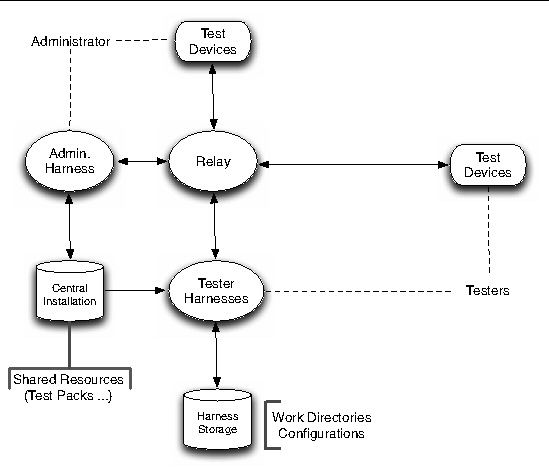| C H A P T E R 1 |
|
Shared and Local Relays |
In a standard Java Device Test Suite installation, harnesses and test devices share a single instance of the Relay as shown in FIGURE 1-1. The Relay acts as an intermediary between harnesses and test devices. Harnesses send test bundles to the Relay, which sends them to test devices in response to HTTP requests. The devices send the HTTP requests over the mobile network (over the air) or a local area network. Test devices return results to the Relay, which returns them to the appropriate harness. When a test needs a file, such as a media file, it sends a request to the Relay, which returns the file.
FIGURE 1-1 Standard Shared Relay Installation

However, mobile networks can be slow for testing, and some devices do not support local area networks. Some of these devices support HTTP over a serial cable, which is fast, but limited: The device can only communicate with the harness host that is connected to the serial cable.
In this case, a shared Relay is usually not practical because the shared Relay is located on a host that is remote from the tester’s workstation (harness host). A tester could install a complete Java Device Test Suite on the tester’s host, which would create a “private shared Relay” that a limited device could communicate with. But multiple testers would then have multiple Central Installations, which would eliminate the administrative advantage of a single shared Central Installation. There are other potential workarounds, such as port forwarding and network address translation, but they cannot be used at all sites.
Local Relays, shown in FIGURE 1-2, are the solution to testing devices that can only communicate with the harness host that is connected to the serial cable.
FIGURE 1-2 Optional Local Relays Installation

Independent of supporting devices with limited communications, local Relays distribute the Relay workload, potentially providing better performance than an overloaded shared Relay. Local Relays can also be useful when testing new test packs. Test developers can use local Relays which isolate their activities from the Relays used for production work.
An installation with local Relays can have as many of them as desired, up to one per test harness. One shared Relay is also required for test pack installation and the administrator harness, which cannot use a local Relay. Testers who have a local Relay can switch their harness between their local Relay and the shared Relay. Switching makes it simple to test devices that can communicate with a shared Relay.